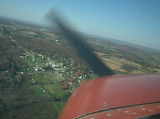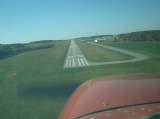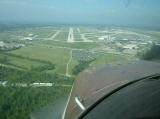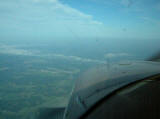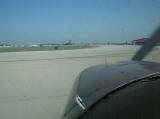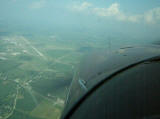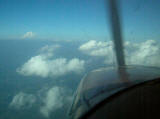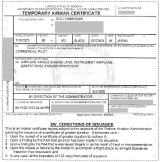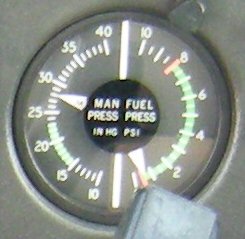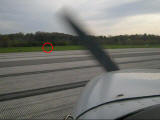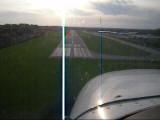Captain YS's Flight Log Book |
| [2011] Previous Articles [2006 and before] [2007] [2008] [2009] | |||||||||||||||||||||||||||||||||||||||||||||||||||||||||||||||||||||||||
Å@ Å@ Foliage-watching flight & Hovering in a Cessna I need to decide from which of the two flight schools, PFTC at Allegheny County airport or Moove Aviation at Beaver County airport, to get my flight instructor certificate. PFTC is close. Just 20 minutes drive from home, but I don't like their maintenance. Moore aviation does fabulous job in maintaining their airplanes, but it is one hour drive away from home. I had two minor maintenance problems from PFTC airplanes recently. Once after taking off, frequency panel of COM1/NAV1 started flickering and gone dark. I was able to talk with an ATC with COM1, but I was not able to change frequency any more. I was in VMC (Visual Meteorological Condition) and could come back with COM2/NAV2, so there was no safety concern. But, I couldn't practice ILS approach since NAV2 didn't have glide-slope indication. In another flight, I noticed that the turn indicator and the attitude indicator was disagreeing each other. If I make the turn indicator level, the attitude indicator showed slight left bank. When I made the attitude indicator level, the turn indicator showed slight right turn, and heading indicator started slowly turning to the right. The turn indicator wins! Well, it's not win or lose. The difference was maybe 3 degrees. But, it was enough to make it difficult to fly straight. I was trained to shut off my own attitude sensor and was trained to trust the attitude indicator. So, my instinct tried to keep the attitude indicator level. Then the airplane started turning. Then I realized I should trust the turn indicator instead. So, I kept turning slight left and slight right. Probably, I should have covered the attitude indicator and tried a partial-panel approach. Either incidents were in VMC. So, there was no danger. I could come back to the airport VFR in the worst case. But, should it happened in actual IMC (Instrumental Meteorological Condition), it could have been life and death matter.
On the other hand, I haven't experienced such could-be-serious problems from Moore Aviation. Once the autopilot didn't work. Not a big deal. I'm trained to fly an airplane. Why do I need an autopilot. Once the sensitivity of COM2 came down and I couldn't hear ATIS until I came within 5nm of the airport. Fine. I can ask tower for the weather condition. I'm more concerned about NAV failure since in any situation I need to come back to the airport. I can land without talking to someone in the worst case, but I may need NAV equipment to find an airport. I never had misaligned gyro instruments in an airplane I rented from Moore. If it were 40 minutes away from home. There is no question. I go for Moore. But, it's one hour away. It is somewhat difficult to commute very often. Anyway, I will save at least $3,000 set aside before starting my CFI training. I need to decide by then. Also I cannot allocate time for CFI training in the fall semester, since I am teaching a class on top of two heavy research projects. For the meanwhile, I am trying to fly once for IFR training to regain my instrument skills rusted during my commercial training and once for fun to fly as an actual PIC per month. Today, I flew for an annual foliage-watching flight. Last weekend I walked with a friend through Appalachian trail and the foliage was a little less than peak. I expected today would be pretty much the peak of the foliage. I rented Cessna 172M, N30181 from Moore Aviation, and took off Beaver County airport around 10:30am with two of my friends. I requested flight following to Somerset County airport (2G9) and the Pittsburgh Approach gave me clearance for class B airspace at 5,500ft. I climbed and flew on course. I wanted to make it a cross country time. But, the forecast was predicting a potentially strong gusty cross wind. The nearest forecasting station was Johnstown airport (KJST), and it was predicting wind 280 at 14 peak gust 25. Somerset county has runway 7-25. If the wind was same as forecasted, 30 degree off at 25kt, which is converted to about 12kt cross wind component. I can take 12kt cross wind. But, if it shifted to the north a little bit, the cross wind component could exceed 15kt. I wouldn't venture landing in such a strong cross wind. I was thinking to give up logging cross-country time if the cross wind is too strong. When I came close to the airport, I heard on the radio that the wind was 290 at 11 peak gust 19. It was shifted 10 degree to the north, but weaker. My friend riding on my right quickly calculated 19 sin(40 degree) on his iPhone, and gave me 12kt cross wind. I can take 12kt cross wind. I flew over the field, then made a descending right turn to join left downwind runway 25. Then made a touch & go. This touch & go legally made this flight a cross country.
Then we flew sight-seeing around Somerset. As I expected, the fall foliage was at its peak. At higher elevation, some trees were already losing leaves. If I waited another week, I would have seen a bolder trees rather than red, yellow, and orange trees. It is so nice to fly. It is especially nice to see four seasons changing from the air.
While flying, I spotted a helicopter that looked like an army AH-64 Apache helicopter. In fact, I saw AH-64s training over Appalachian mountains many times when I was driving on I-76. I wondered if I was wandering into a military training airspace. I looked at the chart again, but nothing was there. If it were late afternoon, it could have been an AH-64 flying back from an air show or an event, but it was around noon. I am still curious what that Apache was doing there. It was roughly 7 or 8 nm north of Somerset. Then we headed west to come back to Beaver. To cross the mountains, I climbed up to 6,500ft. Then, I noticed that although my airspeed indicator was showing 110kt, my portable GPS was saying ground speed of 60kt. Wow! I was flying into 50kt headwind. The air was smooth. I couldn't believe I was in such a strong wind, especially over a mountain. .... Cessna 172's stall speed with 30 degree flaps is a little less than 50kt. Can I stop in the air if I do slow flight here? I pulled the throttle, reduced speed, flaps down, then finally set for 50kt flight. I looked down, and I was not moving! I was hovering. I was stopping in the air in a Cessna! I finally hovered my airplane! I've been wanting to do it once. Then I recovered 110kt and flew at 60kt ground speed until I cleared the mountains. As soon as I crossed the mountains, I descended to 3,500ft. The headwind was decreased to 20kt. In return, the air was a little rough. I am ok with rough air, but this time I had two passengers. I wanted to be in a smooth air, but anyway I had to go below Pittsburgh class B. I couldn't do anything for the turbulence. Then I kept on for Beaver County airport with my portable GPS. Beaver County airport is still a relatively difficult airport to find for me. Allegheny County airport has so much landmarks. But, Beaver County airport appears as if it were buried in a forest. I wish I am able to find it without help of GPS because I would fly out of Beaver very often. It's the end of October. Soon I will start hearing AIRMET Icing from the briefer.
Every year, mid July, there is a big air show in Dayton Ohio. Dayton is a special city for airplane enthusiasts. Wright brothers were born in Dayton. Now, Wright-Patterson Air Force base, which is the center of U.S. Air Force Research, is located in Dayton. And, right next to the air base is the National Museum of U.S. Air Force. If you are an airplane fan, Dayton is the city you would want to visit in your life time. Dayton is about five hours drive from Pittsburgh. And, in a usual year I visit Dayton air show with my wife. We spend one or two nights in Springfield and visit the air show for both two days. However, this year, Dayton air show was scaled down quite a bit compared to a regular year. Also we spent some money already for visiting Chino air show this year. So, we decided to skip Dayton air show this year. For whatever reason, Dayton air show scales down once every a few years. I suppose this bad economy was the reason for this year. Dayton air show lets general aviation airplanes fly in for visiting the air show by keeping the south runway open as long as possible. It is possible because Dayton International airport has three long runways. If I drive five hours one way, it is long and tiring. But, it would be just two hours if I fly there. So, I changed my mind and planned to make a day trip to Dayton by renting an airplane with my instructor and another pilot friend.
The airplane was N6149S, which I used for commercial training. I realized I haven't flown this airplane for more than two months since I got my commercial-pilot certificate. I wanted to fly IFR, but this airplane's second VOR is inoperable, and PFTC has no intention to repair it. Without the second VOR, I cannot perform a required VOR cross-check for an IFR flight. So, I had to fly VFR. I mainly relied on my portable GPS. And, also prepared VOR-based plan so that I can always switch to VOR-based navigation in case of GPS failure. I woke up at 6am and got to the airport at around 7:30am. PFTC was not open yet, but the airplane was outside. I finished pre-flight inspection and waited for my instructor. We took off at 8:24am. Over Wheeling, I saw fog over Ohio river. The sky was clear, and the air was very smooth. Only one thing that bothered me was that the airplane wanted to turn right if I kept the control yoke neutral. I tried to counter the tendency by the rudder trim. But, it didn't work. Probably aileron was not adjusted right.
I flew a little south of the direct course to Dayton since I noticed that I could be always within 10nm of at least one airport by flying along I-70. If I keep 6500ft, I would always be able to make an emergency landing to an airport in case of engine failure. However, as soon as we crossed the Ohio border, everything was flat. That's right. Ohio is a flat state. I can make an emergency landing virtually everywhere. I felt I should have just flown a direct straight course. We were flying on VFR flight following. We talked with Pittsburgh approach, Cleveland center, Indianapolis center, and then Columbus approach. After passing Columbus class C airspace, we were handed off to Dayton approach. But, Dayton approach was in chaos dealing with numerous aircrafts flying in for the air show. I was directed to fly toward runway 24L, but never handed off to Dayton tower. Five miles before the runway, I called "Dayton approach, Skylane 6149S, five miles final." But, no response from the ATC. At four miles final, I called again and was neglected again. At three miles final, "Dayton approach, Skylane 6149S, three miles final. Shall we contact tower?" The call was neglected. We are not allowed to land without a clearance from Dayton tower.
With no choice, we went around. If you were parking your car in the Dayton air show parking and saw a Brown and White Cessna going around at around 10:30, you must have seen a Cessna flown by me. I was getting desperate. "Dayton approach, Skylane 6149S going around 24L. Do you want me to call tower?" Dayton approach ignored again. We turned cross-wind, and then downwind. I spotted one Cessna on my right incoming to my way. I made a right turn to avoid it, but the Cessna also made a left turn to my direction, so I turned back to downwind. I made a call again. Finally Dayton approach replied with nonsense. "The airplane just called, stay out of class C. Are you already sequenced?" Oh, come on! We were on downwind. Weren't they looking at the RADAR? That call made me frustrated. I replied "Yes, we were. We were told to line up with 24L, and you never gave us 'contact tower'. We went around and on extended downwind. Will you give us new vector or do you want us to contact tower?" They finally realized the situation and told us to contact tower. Soon, Dayton tower told us to follow a Moony on final and cleared to land.
On the ground, it turned out that when our airplane, N6149S, was approaching runway 24L, a Piper Cherokee with call sign ending with 49W, and another airplane with call sign ending with 419 were also incoming at the same time. Since air traffic controllers usually use only last three letters of the call sign to identify an aircraft, presence of 49S, 49W, and 419 created a confusion, and they apparently mixed up. When I was desperately calling Dayton approach, they probably thought either 49W or 419 was calling, and maybe they were wondering why saying "5 miles final". In this situation, since the runway was clear, and numerous aircrafts were flying in the area, just landing the runway in front of me could have been the safest option. However, if I land without a clearance, it is a clear violation of Federal Aviation Regulation, and if I do it in such a large airport, my license might be suspended. I suppose going around was the safest option within the regulation. My instructor suggested to file a NASA ASRS. So, I did after coming home. Anyways, we arrived at Dayton in one piece. Finally, I flew in to an air show. It had long been a thing I wanted to do. My dreams came true! I'm going to post some photos from Dayton air show in my airplane photo gallery later. So, I'm not going to talk about the air show here.
After the air show, we had to head home. But, I saw clouds to the direction we wanted to fly. I was worried about a thunderstorm. But, the briefer said the condition was not too bad. There were some isolated storm cells, but in general the weather was VMC. We took off around 5:30pm and headed home. Wow! It was great! Usually it takes an hour to just get out of the air show parking. This time, we were able to take off with little wait. Dayton approach told us to fly south until reaching 3500ft, and then head on course to Allegheny. This course made us fly almost directly above Wright-Patterson air force base. I saw one C-5 Galaxy parked in the ramp of the air base. Soon Dayton approach said "Blue Angels 9" was in front of us. It was Blue Angels' C-130 "Fat Albert!" I suppose it was taking a local press people for a sight-seeing tour after the show. I regret I put my camera with a tele-photo lens in the baggage compartment. I should have kept it with me. It could have been a rare opportunity of taking an aerial picture of Fat Albert. I missed the call, but my instructor said Dayton approach once said "Blue Angels 9, say the type of aircraft." Which sounded funny, but probably the ATC assumed Blue Angels 9 was a F-18 and appeared too slow since it was actually a C-130. We initially stayed 3500ft to see the weather condition. But, after passing Columbus area, the sky was almost clear. So, we climbed up to 7500ft. I had to turn left and right to avoid some isolated clouds (I wish we had been flying under IFR so that we could just go through those clouds!), but in general most of the clouds were below us. It was nice to see clouds underneath. We never encountered a thunderstorm and came back to Allegheny all right. I came back to my apartment around 7:50pm. It was 1.9 hour flight. It is not impossible to make a day trip to Dayton from Pittsburgh by car. However, if I do that, I would need to leave Pittsburgh like 3am and come back at around 11pm. It was so nice to make a day trip by an airplane.
Re-gaining Instrument Currency Since I have instrument rating, I am allowed to fly in a low-visibility and low-cloud condition. I can file an IFR flight plan and go. But, it is only if I am instrument current. To be instrument current, I need to fly at least one holding and six instrument approaches within preceding six calendar months. Strictly speaking, I need to do one holding, six approaches, and one course tracking. But, I have never seen any instrument approach procedure that does not include a course tracking. So, if I fly six approaches, I automatically fulfill one course-tracking requirement. I haven't practiced instrument approaches and holdings for a while because I was concentrating on finishing up my commercial certificate. My instrument currency has expired for a while. Now I finished my commercial training, and resumed regular instrument practice. First of all, I wanted to re-gain my instrument currency. I flew two flights from Allegheny County airport for instrument training on 6/17 and 7/2. I flew N9417L for the first flight. N9417L was I believe the second oldest Cessna of PFTC, and it doesn't have GPS. This time, I didn't practice holdings and concentrated on ILS approaches. ILS 28 approach to Allegheny was the approach procedure that I have practiced the most. In case I encounter an un-forecasted weather condition after taking off Beaver County or Butler County airport and if I determine that returning to the original airport is not safe, ILS 28 to Allegheny is my last line of defense. It is of course good to practice different approaches, but repeating a same procedure again and again is also a good way to acquire a skill. I was expecting to fly a poor approaches by myself because I haven't practiced approaches intensively for more than half a year. In contrary, I did pretty well. Calm wind and stable air also helped, but I was able to follow localizer and glide slope all the way to the minimum descending altitude. I usually take my foggle off 100 or 200ft above MDA, but this time for the last full-stop landing, I kept on my foggle really to the MDA because I was able to keep glide slope so well. In Cessna 172, MDA is roughly 200ft above ground. If I keep foggle on to the MDA, I don't have much time before round out and flare. During instrument approach, I need to keep 90kt, but I cannot lower flaps to 20 degrees until I reduce speed to 85kt. And, this time, I was flying at 100kt on final, which was my mistake. So, I had to first reduce speed by 15kt, then lower flaps after taking my foggle off. I was able to do that, but I didn't have time to lower flaps to 30 degrees. I ended up with rounding out at 80kt with 20 degree flaps and used two thirds of the main runway of Allegheny county. I usually need less than a third of the runway. My instructor said it was like a jet landing. This was something I had to improve for the next time. For the second flight for 7/2, I reserved N430U. But, I was re-assigned to N4739J due to maintenance schedule. But, N4739J is the oldest Cessnas of PFTC, and one of the instructors told its navigation equipments are iffy and he wouldn't use it for instrument training. So, I wanted to avoid this airplane. I looked at PFTC reservation web site and realized N596CS was available, which is as new as N430U. I switched my reservation from N4739J to N596CS. But, the next day, I was again re-assigned to N4739J because N596CS was also down for maintenance. I felt frustration, but if it was for maintenance, I had nothing I could do. In fact, when I flew N4739J, Nav 1 was iffy. I think I set frequency of Ellwood City VOR before take off. During the climb, NAV 1 indication came on and off. (In fact, that occasion made me purchase a portable aviation GPS.) I was worried if I could really fly an instrument training in that airplane, but I anyway drove to PFTC. By the way, a B-17 Flying Fortress was in Allegheny for an event for the Independence-day weekend. Because it was still a day before the event, the B-17 was parked in front of the tower and nobody was around. I'm always fascinated to see such a historic airplanes coming to local airports, just as usual, not even for an air show.
When I came to PFTC, lucky to me, N430U was already up again. I switched to N430U. This airplane is the closest Cessna I rent from Beaver County airport. I took off and practiced holding over Allegheny VOR. It was almost zero wind, and I was able to fly a holding pattern like a textbook. Then, I flew VOR-A approach to Allegheny, which I did ok. I flew ILS 28 next, which I did very well in the last flight. But, this time I over-flown glide slope a bit. I didn't notice I reached the glide slope because N430U is equipped with HSI, which stands for Horizontal Situation Indicator. In typical other airplanes, ILS indication, localizer and glide slope, is shown on NAV 1, which is located top right from the six main instruments. But, the ILS indication in N430U is shown in HSI, which overlaps the heading indicator. Since I am so used to look at top right from the main instruments, I was waiting for the glide slope needle to appear in that instrument, which actually was Nav 2. I made a same mistake when I was training for my instrument rating. So, I tried to be careful not to do the same, but I ended up with making the same mistake. Nonetheless, I noticed before it was too late. I was able to re-intercept the glide slope.
For the last approach, I tried to maintain 85 to 90kt, and took foggle off 50ft above the MDA. This worked out all right. I was able to stop within less than a third of the runway length. I re-gained my instrument currency, and I was glad to find that my instrument skill was not so rusty. After my flight, I flew to Franklin Venango Regional airport in a Moony Bravo flown by my instructor for dinner. The original plan was, I think, I was supposed to serve as a safety pilot for his instrument training, but we didn't do instrument approach anyway. So, I was sitting just as a passenger. The return flight was completely night. I enjoyed night scenery. When we arrived, it was almost midnight.
Honestly, I was almost losing hope to get it done this month since I was going to be very busy for numerous events and trips in the last half of this month. It was my very last chance in this month to go for a check ride, and I made it! The weather finally gave a break just in time. Finally, I am a Commercial Pilot! Actually, I haven't flown Cessna 182 RG for three weeks. I was a little bit worried that I was forgetting feelings. However, I actually flew better than my training. My biggest weakness was in Lazy Eight. But, I did my best Lazy Eight in the check ride. I have my temporary certificate now, and I should receive it within two to three weeks. I am leaving Pittsburgh and going to visit Chino Air Show tomorrow. It is good to leave this big milestone behind. I will enjoy Chino air show without worrying about my commercial check ride! Alert Stand-by for Commercial Check Ride So, I had to cancel my check ride yesterday. The examiner will call me whenever he finds some time, and I will scramble to the airport and go for a check ride. (Isn't it called an alert stand-by?) Commercial Check Ride Pre-poned (and most likely postponed again) Curse Pittsburgh's weather. Turned out, the examiner needs to visit his family for mother's day, and he cannot give me a check ride tomorrow. So, the schedule is moved ahead by one day (,which is today). I am supposed to take off as soon as the weather recovers. Right now, the sky is not too bad, but the wind is blowing like a hurricane. The forecast is not expecting any better condition through the day. I don't think I can take off in this condition. Back on Track - 3.1 hours of night solo cross country So, it turned out I needed another 3 hours of night solo time. Night PIC time was not good enough. To satisfy this last requirement, I scheduled to fly from PFTC for Tuesday and Wednesday nights. PFTC ceased rental indefinitely, but they allow solo flights if it is a requirement toward a new certificate. That's what I heard last Saturday. I called PFTC in Tuesday afternoon to confirm I was going to fly night solo, but they said they couldn't allow me to go for night solo because it was too gusty and I need to do three night landings with an instructor within preceding 30 days to go for solo. What? Why they didn't tell me about the requirements. And, windy? It was windy during the day, but the forecast for the time I was supposed to take off was variable at 3kt, which was almost zero wind. How weaker can the wind go? It was ridiculous. I will never be able to fly night solo from PFTC, if absolutely zero wind was one of the requirements. Honestly, I was pissed. If they don't allow me to go for night solo, I don't ask them. I called Moore Aviation, and reserved an airplane for night. They do require a private pilot to fly with an instructor at night before renting for night flight, but it is if the pilot is not instrument rated. Since I was already instrument rated, they let me go. Isn't it reasonable? How come PFTC doesn't allow someone who is instrument rated and is flying regularly to go for night solo? I came home from work at around 5:30pm. I had early dinner and was watching TV news. I've got one problem there. The weather was supposed to last until Thursday, but the forecast has changed and it was predicting thunderstorm late Wednesday night. There came a possibility that I was not going to be able to fly Wednesday night. I changed the plan and decided to fly three hours in one flight. If I fly three hours, why not making it a night solo cross country instead of just night solo? I decided to fly to Allegheny County and do some stop & goes to re-gain my night currency, and re-fuel there. Then fly to Latrobe and do one touch & go, which makes it a cross country, and then come back to Beaver and fly to north practice area to do some practice for my commercial check ride, then come back to Beaver as soon as I was certain to earn 3 hours of night solo time. I left my apartment at 7:30pm. The downtown rush hour was already over, and I arrived at Beaver County airport at 8:20pm. I explained I was going to fly for 3 hours and might come back close to mid night. But, I was told to come back before midnight. Apparently, it was Moore Aviation's rule. This constraint made it impossible to re-fuel at Allegheny. To qualify as a night flight, I need to take off after the end of civil twilight, which was 8:50pm. If I fly 3 hours non-stop, I will come back at 11:50pm. 10 minutes before the mid night. But, if I stop at Allegheny for re-fueling, it would take more than 10 minutes. Then, even if I come back exactly at mid night, I will not earn 3 hours of night solo time. I was hoping they topped off the airplane, if it was topped off, it could fly 4.5 hours non-stop and I would not have to re-fuel at Allegheny. I walked up to the airplane and looked inside the fuel tank, and it was topped off! Thank you Moore Aviation! Engine oil was at 7qt. It is recommended to add engine oil up to 8qt before a long flight, but as long as I have 6qt, it should be safe. That was 8:30pm. I performed pre-flight inspection quickly and mounted my on-board camera and portable GPS. In case of total electrical failure, it is advantageous to have a portable GPS, which is driven by its own battery. I had 6 flash lights including one attached to my headset, and one attached to my shirt with a clip. I was well prepared. I started the engine at 8:40pm, ran up, and took off exactly at 8:50pm.
I headed for Allegheny County. The sky was not totally dark when I took off, but within minutes, it became dark. And I was flying above the sea of lights. Cessna 172R had two panel lights. One lights individual instruments, and the other lights entire instrument panel from the above. For some reason, the latter one didn't work. When I pre-flighted, I made sure panel light was working, but since I saw light for individual instrument was working, I was forgetting about the one that lights from the above. One of the two panel lights was working, it was safe. But, only problem was, VOR 1 and Turn coordinator were not lit. I had to use my flash light to see those instruments. In fact, I couldn't light turn coordinator every time I turned, so I relied on my feeling for coordinating a turn. If I start relying on my feeling to control pitch and bank, it's going to be a problem, but turn can be coordinated well by feeling, actually. However, on the way to Allegheny, I dropped one of the flash lights on the floor and couldn't find it. It was ok. I had five more flash lights. It is important to carry many flash lights for a night flight. The air was stable, and the airplane was flying smoothly as if I were sailing over a calm water. I wanted to fly close to downtown to enjoy night view of downtown, but Major League Baseball game was going on, and I was not allowed to come within 3nm of the stadium. I had to stay far from downtown. I flew farther east to avoid that restricted air space, and came to Allegheny. Oil pressure and temperature were both good, and I had plenty of fuel. I did four stop & goes and one touch & go before heading for Latrobe. On the way to Latrobe, another flash light broke. I couldn't turn it on any longer. That was a slight increase of the problem. I had more flash lights, but one of them was attached to the head set. It was good for looking at instrument, but not good for looking at chart or memo on my lap. Another one was attached to my shirt by a clip. I could start using this one primarily, but it had one AAA battery. I had to save battery. Another one was too big to fit in my chest pocket. I could use it in real emergency situation, but it was somewhat bulky. Then I remembered I had another one. Which had flexible head, and I've just replaced its battery for this night flight. I took it from my flight bag and slipped it into my chest pocket. And from then on, I used this one primarily. It is really important to carry many flash lights for a night flight. With a GPS, I found Latrobe with no difficulty. I came to Latrobe before the tower was closed. It is easier to fly at a towered airport at night than a non-towered airport. Surroundings of Latrobe airport was not totally dark, and it was easy to do a touch & go. Then I headed toward Rock airport (9G1) to avoid flight restriction around the ball park. At that time, I already flew 1.5 hours. I flew over 9G1, and then turned toward Beaver. Around this time, I was changing the setting of some lights, and suddenly, the second panel light came back alive. Now I could see all the instruments without using my flash light. Beaver control tower closes at 9pm. So, when I came back to Beaver, Beaver County airport was a non-towered airport. It meant that I had to control runway light by a radio. If I click on the transmit button 3 times in 5 seconds, the runway light becomes low intensity, 5 times for medium, and 7 times for high intensity. But, what if it didn't work? If I cannot see the runway light, I cannot land, and I would have to divert to a different airport, like Allegheny. I wanted to confirm I could see the runway light before running low on fuel. I came close to the airport, and clicked the radio button 7 times. But, I didn't see the light. Tried 3 times and 5 times, but no difference. I came directly over the field, and saw runway lights at low intensity. Apparently, unless someone turns it up, the runway light stays low intensity. The pilot-controlled lighting system didn't seem to be working, but as long as I can see the runway, I can land. It was good. I turned north and flew to the practice area. I practiced some maneuvers, and at one time, I did Chandelles a few times to go up to 6000ft. It was a magnificent view. The visibility was almost unlimited. I saw sea of light of Youngstown and New Castle. I have never flown at 6000ft at night. I flew close to 6000 at night when I was training for my instrument rating, but I was wearing a foggle. I didn't remember to see such a nice night view from that high. I like night flying. 20 minutes before I have enough flying time, I flew over Beaver to 5 miles south west where it is easy to join left downwind runway 28 at 45 degree angle. I was circling there until 6 minutes before I have 3 hours and then headed for Beaver. When I reported my position, the runway light suddenly turned to high intensity. I saw some hangars open. Maybe someone listened to me and turned the light up. Airplane was good, oil temperature, oil pressure in green arc, I had plenty of fuel reserve. One last thing I was worried about was a black hole landing. If the surrounding area of the airport is totally dark, the runway lights may appear to be floating in the air. In that case, it would become very difficult to accurately perceive the altitude off the ground. In fact, I experienced that condition February of last year, when I took a visitor from Japan to Franklin for dinner. I leveled off slightly higher than ideal and felt the airplane sank longer than I wanted. But, it turned out that the surroundings of Beaver County airport were much brighter than Franklin. In fact, I could see the runway number from short final. With no difficulty, I made a smooth landing. I exited the runway and it was exactly 3 hours from take off. Taxing to the ramp gave me extra 0.1 hours. So, I made 3.1 hours of solo night cross-country time, and I now satisfy the last requirement to become a commercial pilot. I called the examiner today, and I will fly for my commercial certificate on Sunday. By the way, the flash light I dropped was found between the seat and the door. By the way, it is 11:50pm Wednesday. Where is the thunderstorm? I see nice weather outside.
Commercial Check Ride Postponed Not for the bad weather. But because I was stupid. I was double checking my logbook and making a table of required flight experience and my current experience so that the examiner can easily check that I satisfy all the requirements. From the top of Federal Aviation Regulation 61.129,
OK. I thought the last requirement was night PIC, not night solo. But, anyway I should have flown more than 5 hours solo for getting night currency, haven't I....?. No. I have only 2 hours now. 3 hours short.... When I realized, I felt my (remaining) hair raised. I called PFTC this morning and made two reservations for night flight on coming Tuesday and Wednesday. Forecast is calling for a good weather condition for both two days. I hope this time I can really finish all the requirement and can go for the test in the next week. Commercial Check Ride set for the coming Sunday I will try my commercial check ride for the coming Sunday, May 1st. The weather forecast is not promising at all. It is predicting thunderstorm. But, if I cannot fly, I will have oral exam only and will fly on a different day. Barely passed the Commercial Stage Check I have barely passed the stage check. The original plan was to have oral exam from 10 to 12pm, and then flying exam from 12pm to 2pm. But, oral exam took long. It took 3 hours. It was not because I was doing poorly, but because the instructor (mock examiner) covered almost all items that can be asked by the actual examiner. I think I did all right. I was pretty hungry when I was done with the oral exam. But, I started the flying portion immediately. When I started the flying portion, the examiner told me a shocking news. According to him, I need to perform at least one instrument approach during the exam because I am already instrument rated. I was thinking to get commercial certificate first, and then re-train to refresh my instrument skill. I was putting my instrument training aside because my commercial training was taking infinity. If I knew I was going to do an instrument approach during the commercial check ride, I should have practiced instrument approaches more often. It was too late though. Anyway, I took off at around 1:30pm. First, I pretended to fly a cross-country flight to Clarksburg, WV. In the middle of the flight, the examiner was going to tell me to divert to another airport. When I leveled off, I felt strange. The airplane wants to go up today. Also, the rudder seemed to be biased to the right. I was supposed to push right rudder during take off, but today I didn't have to put much pressure on the right rudder to stay coordinated. I tried to adjust it by rudder trim, but didn't work well. I had a bad feeling about the maneuvers that I need to perform later in the flight. The cross-country part went almost all right, except that I missed one of the check points "Marianna." I didn't miss, but I didn't positively identify it. Marianna seemed to be a small concentration of houses. I couldn't distinguish it from other houses around there. But, I was also relying on the VOR and DME. I didn't get lost by that. A few minutes after passing over Green County Airport, the examiner told me to divert to an airport other than Green County Airport. Washington County airport was the next closest public airport, but he told me to assume that bad weather was approaching from the south west. He wanted me to choose something to the east. I picked Connelsville airport. I calculated heading 070, and distance 25nm. I was supposed to be there in 12 minutes. Actually, the heading should have been more like 080. It's very difficult to measure accurately in the airplane. But, I was able to find the airport to the right of my airplane, and I arrived there in 11 minutes. It was ok. I made one touch and go and started maneuvers. I did chandelles twice, and was told to do steep spirals from that altitude. I was at 4,200ft, although I usually practiced steep spirals from 5,500ft. And, the examiner cut the engine before I reached over the reference point. So, I guess I was at 3700ft or so when I started the turn. I thought I was too low to complete three turns from there, and it was actually. I was not able to complete three turns. I was descending to a river, and I hoped I was able to complete the third turn before reaching 500ft from the river surface, but he told me to go up because I was too low. If it were an actual exam, I failed. If I went up by my self, I failed anyway because I didn't complete three turns. What else could I do? I thought I failed at that time. But, the commercial check ride is like a point-based system. I may miss some maneuvers, but if I do good in other maneuvers, the examiner does not have to re-test those items when I re-take the check ride. So, I should do my best for other maneuvers. Next one was slow flight. It's supposed to be an easy one, if the airplane reacts as usual. But, for some reason, this guy, Cessna 182RG, wanted to go up today. I reduced the throttle quite much, a lot more than I did in a usual training flight, but the airplane tended to go up. The psychology in that situation was:
I started at 4,200ft, but ended up with climbing up to 4,400ft. Why this guy wants to go up this much today? What happened to this airplane? Well, it was better than the airplane was falling down, but gaining 200ft during the maneuver was totally unacceptable to pass the actual check ride. I tried to dismiss my internal voice "it's not right" and pulled the throttle a lot and descended back to 4200ft. The following power-off stall recovery went all right. Then I did steep turns. For a private pilot, it is 45-degree bank turn. For a commercial pilot, 50 to 60 degree-bank turn. This was my favorite maneuver. I was very much confident doing it. I made a steep turn to the left, and went well. I was in control, and stayed within plus-minus 100ft from the initial altitude. I rolled off, and starting the right steep turn, and realized I gained 100ft in a second or two. Why? Why this guy goes up! I slightly reduced the throttle and entered the steep turn to the right anyway. In the middle, totally opposite happened. I heard a stall horn. It's not fun to stall in the middle of a steep turn. I immediately reduced the back pressure, and the airplane lost 200ft. I failed this maneuver also. I had no idea what was going wrong. This airplane first wanted to go up as if it was producing too much thrust, and then stall horn? It didn't make sense to me. I was too frustrated, and asked him to let me do it again. The second attempt went all right. Next one was lazy eight. I practiced this maneuver in Cessna 172 yesterday to prepare for this stage check. I needed to roll out and level off at the same altitude where I started the maneuver. You know what happened? I gained 200ft. Why? Why does this airplane go up too much? The right throttle setting was too off from the setting I used to use through my practice. I could do nothing well today. What a sad flight! After doing eights-on-pylons, I flew back to Allegheny IFR. I shot ILS approach to Allegheny. I was totally expecting to screw up. But, it worked out ok. Once I drifted to the left, and had to take 15 degree wind-correction, although the forecasted wind was light and variable, but I managed to come back. When I removed my foggle, I was right in front of the runway. Then I did some touch and goes and finished the stage check. I was totally expecting that I failed. But, to my surprise, the examiner passed me. He said that the air was too bumpy, and he expected me to do better in a smoother condition. He guessed that I might have hit a wind shear when I heard the stall horn during my right steep turn. Nonetheless, he suggested me to go up with my primary instructor to practice maneuvers before the actual check ride. I personally thought I would need to practice approaches, too. I was exhausted and hungry when I came home. But, this airplane was strange today. I have no idea why this airplane wanted to go up this much. This airplane has fixed-speed propeller, and I control the engine output by watching manifold-pressure gauge. The gauge has a green arc, and I usually keep the manifold pressure within the green arc. The bottom of the arch is 15 inches. I usually used 17 to 18 inches for maneuvers. However, I had to reduce throttle to even below 15 inches, like 13 inches to stay level and at the maneuvering speed. If I add power to 15 inch, the airplane either accelerated beyond the maneuvering speed or climbed up. The thing is, I had been practicing in this airplane and remembered the throttle setting for different situations. The right setting may vary depending on many conditions. But, today, the right setting was too much off from the setting I knew. I had no chance of doing good in this situation. I hope this doesn't happen in my actual check ride. Anyways, it was one step forward. I will practice maneuvers and approaches and then go for the actual check ride.
While my commercial stage check is approaching, a volunteer aerial photography mission is also approaching for the next week. There is a non-profit organization called Pittsburgh Sakura Project, which has been planting cherry trees in the North Park of Pittsburgh. The organization will hold an annual planting ceremony next weekend, and I am planning to overfly the scene and my wife is going to take aerial pictures. I planned to fly a practice run last weekend, but typical Pittsburgh weather (high wind in spring) forced me to cancel the flight. So, I tried again on Wednesday (04/07) in the evening. But, it was windy again on the day. The forecast was saying the wind should die down by the evening. So, I was keeping eye on the weather report and waited for the wind to die down. I am confident in taking 12kt cross wind. I should be able to handle 15kt cross wind all right. But, if more than 15kt cross wind is forecasted, I wouldn't take off. The weather report was still reporting gusty cross wind when I left CMU. But, the forecast had been consistently saying the wind was going to die down. I decided to come to the airport anyway. I headed for Beaver County Airport at around 4:30. The road was unusually crowded, and I arrived at the airport at 5:45. (Usually it takes 45 to 50 minutes.) I quickly did pre-flight inspection, and I was able to start the engine at 6pm. The sunset time was after 7:30. I had enough time to go to the North Park and come back. When I came to the runway 28 threshold, a fox was prowling nearby. My on-board camera captured the fox although it is not clear enough to see the shape. According to an instructor, the fox is living somewhere in the airport. At this time, the fox was complying with the Federal Aviation Regulation and didn't come in to the runway. Then, I navigated to the North Park with my portable GPS. I circled over the area four times and took some pictures. This time I was flying solo and stayed at 1500ft AGL. Next week, my wife will take pictures and I will be able to concentrate on flying. So, I am planning to go down to 1000ft AGL.
Then I came back to Beaver and did three touch and goes. After the third landing, I wanted to make a full-stop landing, when the control tower told me that a fox was prowling on the runway. I was trying to spot a fox when I was approaching for landing, and there it was! The fox was sitting on the runway! The fox was violating the Federal Aviation Regulation! It was too close to the centerline. I went around. I tried to fly close to the fox to wave it off, but my attempt apparently didn't work. The tower said the fox was still on the runway.
I happened to have read an article in AOPA Pilot magazine about a story of a pilot who took off for night landing practice and almost ran out of fuel after going around several times because his first several landing attempt didn't work. What if I end up running out of fuel because of this fox? I took off with roughly 75% fuel, but should I have topped off? (I still had almost half the tank of fuel at this time, which was good enough for more than 2 hours.) I made another traffic pattern and approached to the runway. The fox was still on the runway, but farther to the right. I landed without killing the fox. If the weather is good, I will fly for a practice once again on Saturday, and hopefully I will fly to the practice area to practice some commercial maneuvers. Gearing Up for the Commercial-Pilot Stage Check After months of delay, finally I finished all the flying lessons for my commercial pilot certificate. I am going for the stage check for my commercial pilot check ride. Stage check is a mock exam for the real exam, and a senior instructor of the flight school will fly with me and evaluate if I am really ready for the commercial check ride. So, it's not a requirement. But, it would be a waste of money if I go for the actual flying exam when I have virtually zero chance of passing. So, it makes sense to pass the stage check and then go for the actual exam. As for my confidence, I am not as confident as I was before my instrument check ride. One reason was I was not able to fly regularly for training due to bad weather. It was cloudy every weekends in January and February. The weather finally recovered in March, but then I got awfully strong wind. I wanted to fly every week to get ready for the test, but actually I was able to fly once every two to three weeks. Another reason was high rental fee of the aircraft I was using for my commercial training. To get a commercial pilot certificate, I need to demonstrate proficiency in a complex airplane, which has retractable landing gears. The only one single-engine airplane with retractable landing gear at PFTC was Cessna 182RG. Its rental cost (per hour) was $35 more expensive than Cessna 172s. I would bankrupt if I continue training until I am 100% confident. I have to go for the test when I am reasonably ready. This week I am preparing for oral portion of the stage check by reviewing materials I studied for my written test. I am also practicing maneuvers in a flight simulator. The flight characteristics of a PC flight simulator (including YSFLIGHT) is not very realistic. Nonetheless, I can practice steps I need to follow. For example, with the current CPU power, it is virtually impossible to simulate the motion of an airplane near and after the stall real time since it is very computationally costly to calculate turbulent air. (Will it be possible in ten years from now? I don't know.) Nonetheless, I can practice what procedure to follow to recover from power-off stall. I need to do: lower nose, max power, carb heat off, flaps 10 degree up, and landing gear up. It is much more effective to do in a flight simulator than doing it completely in my imagination. Let's see if I can pass the stage check in one attempt. I'll upload the result here on Sunday. Two weeks has passed since Pittsburgh had 4th-in-the-record snow fall. The weather has been poor since then, but finally clouds gave way this weekend. My commercial-pilot training has been delayed due to the poor weather. To catch up, I was supposed to fly for my commercial training on Saturday. However, my instructor called in the morning and told he had cold. I had no choice but canceling the flight. But, it was too miserable to me to stay on ground in this first clear sky in more than two weeks. I called Moore Aviation and reserved an airplane for Sunday afternoon. I haven't dedicated one flight for landing practice for a while. I thought it was a good time to do intensive landing practice. Sunday morning was not as clear sky as the day before. Nonetheless, cloud was very high, visibility was more than 10SM, and there was little wind. It was a very nice flying condition. I left home at around 11am and headed for Beaver County. I took off, and just did touch and goes. I did normal landings for the first four touch and goes, and then practiced short approaches. A short approach is also called a 180 power-off approach. When I come to the end of downwind leg, I pull the throttle back to idle and make 180 degree turn to approach the runway. I anyway need to do a short approach in my commercial-pilot exam. It was a good opportunity for me to practice. I have a tendency to be too-high on final during a short approach. In fact, I think Cessna is a difficult airplane to do a short approach because a high wing hides the runway until I turn roughly 90 degree into a short approach. I cannot make a good judgment of altitude until I see the runway. For the first attempt, I was too high on final. If I were doing it in Allegheny County, I might have made it a touch and go because the main runway of Allegheny County is very long. But, Beaver County's runway is not that long. I gave up and went around. In the second attempt, at the end of downwind leg, I pulled the throttle, extended flaps 10 degrees, and waited until the airplane decelerate to 80kt before starting a turn. I also made a shallower turn to make a bigger radius. This strategy worked all right. I was able to touch down nicely on the runway. I practiced two more times and all went well. I hope I can fly as good as I did today in my actual commercial check ride. I practiced short-field landings for the rest of the flight. Cessna 172 flies at 65 to 70kt on final in a normal landing. In short-field landing, I need to decelerate to 61kt. As soon as the airplane touches down, I retract flaps, and apply max brake. In a practice, I don't really apply max brake, but instead just say "max brake." Applying max brake may make directional control more difficult and had contributed to numerous off-run accident in history. If I really need to apply max brake, it would be in an emergency landing to a short strip. Today, calm wind also helped, and I was able to maintain almost exactly 61kt on final. I was able to make really nice short-field landings. If nobody was flying after me, I wanted to to try stopping before the first taxiway intersection, but another airplane was in a pattern when I made the last landing of today. So, I rolled as usual on the runway and took the center taxiway to main ramp. I flew 1.2 hours and did 10 touch & goes. I practiced 11 landings including the last full-stop landing. I wish I can resume my commercial training next weekend. But, the forecast does not look promising. I hope I can become a commercial pilot before summer. First flight of the year
(Finally!) I finally had a narrow chance of flying on this day, and I left my office early and flew from Beaver County Airport. I didn't do anything special. I just wanted to get used to the airport. I took off, then circled over the North Park, where cherry trees have been planted, then circled over the Shadyside Academy, where we took aerial photography of a school event last year. Then, I wanted to go to Allegheny County airport to do some touch and goes, but I ran out of time, and flew back to Beaver.
But, I was not familiar with the area, and I totally relied on my GPS. The airplane was equipped with a dash-mounted GPS, too. So, there was no risk of getting lost. But, I want to be able to find the airport by ground reference. In the worst case, I would call Pittsburgh approach to give me heading. In the worst of the worst case (in which the radio fails as well), I can divert to Rock or Allegheny County. So there is no danger. You may think it is unlikely to experience the worst of the worst case, but I have experienced Push-To-Talk button failure before. I should be (and I am) prepared for such situations.
I wanted to do some touch & goes when I came back. But, the airport was busy, and I was told to make a 360 for spacing. After that, I was told to join final. So I did. The runway came closer. I was at 100ft AGL, when I realized "Was I cleared for touch and go? I guess not." I called Beaver tower and asked if I was cleared for touch and go. But, when in rush, my English pronunciation gets a bit poor, and the tower called me and said "what did you say?" With no altitude left, I had no choice but push the throttle forward and went around. In such a situation, ATC is usually thinking he/she has given me a clearance. So, it is in general safe. I anyway have final responsibility to make sure the runway is clear. But, if an FAA inspector happens to be at the airport, I will be busted. It's safer to go around. Then I did one touch & go and landed. By the way, I borrowed an equipment from a friend called PCAS (Portable Collision Avoidance System.) It tells me if an airplane is flying close to my airplane. It apparently gives some false positives (like, once it said an airplane was 1100 below me when I was at 1100 above ground,) but so far there apparently no false negatives. It should be very useful when I fly for an aerial photography mission.
As of January 1st 2010, my flying time is as follows:
Although it is not required to log actual PIC time (time I actually flew as a Pilot-In-Command without an instructor on board,) I have 109.3 hours of actual PIC time according to my calculation. In fact, Japanese regulation does not allow to log PIC time when an instructor is on board, 109.3 is my PIC time with respect to the Japanese Aviation Regulation. This year, my biggest goal is to become a commercial pilot. I hope that will happen in January. It is reasonably possible if the weather cooperate. But, the forecast doesn't seem to be promising. It may be delayed until February or March. I will post the progress here. [Click here for posts from 2009]
|
|||||||||||||||||||||||||||||||||||||||||||||||||||||||||||||||||||||||||
| [2011] Previous Articles [2006 and before] [2007] [2008] [2009] |
| Comments are welcome.
Send E-Mail to:
|
